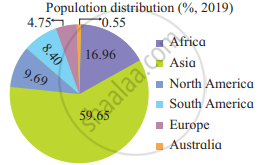Advertisements
Advertisements
प्रश्न
Differentiate between
Rural and Urban composition of population
फरक स्पष्ट करा
उत्तर
| Sr. No. | Rural composition of population | Urban composition of population |
| 1. | In rural areas, people are mainly engaged in primary activities. | In urban areas, majority of the working population is engaged in non-primary activities. |
| 2. | Due to migration of people from rural areas to urban areas, the population of rural areas decreases. | Due to migration of people from different areas to urban areas, the population of urban areas increases. |
shaalaa.com
Distribution of Population
या प्रश्नात किंवा उत्तरात काही त्रुटी आहे का?
APPEARS IN
संबंधित प्रश्न
Give geographical reason
Population density is a function of population and area of a region
State whether right or wrong:
Population density is less in equatorial region.
State whether right or wrong:
Population density is high on Tibet plateau.
Show the following in the world map. Index is necessary
- Uzbekistan
- The canal which make revolutionary change in ocean transport
- Milan
- Andes mountain
- The country which has highest population
- Industrial city in Europe
- Area of lumbering in Asia
Observe the following graph and answer the question given below

Questions:
- What type of graph is this?
- In which continent the land percentage is highest?
- In which continent the land percentage is lowest?
- In which continent 9.2% land is found?
- What is the land percentage of Europe?
Write short note
Effect of relief on population distribution
Where does India rank as a world population?
How much percent of World’s population is in India?
Observe the following diagram and answer the questions given below.
 |
|
- Which continent has the least population?
- Which continent has the least landmass and also the least population?
- Which continent has the most landmass as well as most of the population?
- Which continent is missing in one of the pie charts? Why?
- What is the percentage of population distribution in Asia?
Analyse the economic factors affecting the distribution of population in the world.

